Sayur Lodeh recipe calls for vegetables and tofu that are simmered in coconut milk and infused with a homemade spice paste. This Indonesian dish is a perfect side dish or main course when served with rice cakes or steamed rice.
This recipe for sayur lodeh is based on my husband’s method. When we were living in Singapore, my kids became more familiar with South East Asian food. To my husband, who was born and raised in Singapore, Southeast Asian cuisine was both familiar and comforting. As my kids explored the various dishes, one of my family’s perennial favorites was the sayur lodeh. This dish achieves the trifecta of being healthy, tantalizingly savory, and yet simple.
What is Sayur Lodeh?
Sayur Lodeh describes both the ingredient and method. ‘Sayur’ means vegetable in Malay and ‘Lodeh’ is a specific cooking method where ingredients are cooked until soft. We need to distinguish between lodeh and lemak in the context of this dish, as the terms can be and are used interchangeably. Lodeh is a cooking technique where ingredients are cooked until soft. Lemak, on the other hand, refers to the use of coconut milk as the primary medium of cooking the ingredients. When a dish is lemak, the rich nutty flavor of the coconut is amplified. You may also hear of a dish called ‘lontong’, especially in Malaysia and Singapore. Specifically, lontong is a compressed rice cake. However, since lontong is usually served as an accompaniment to sayur lodeh, the dish can be also be referred to as lontong.
Ingredients in Sayur Lodeh:
Candlenuts:
The other unique aspect of this dish is that it utilizes the full spectrum of the spice islands, with ingredients such as candlenuts, galangal, and lemongrass. Candlenut may be unfamiliar to some of you. If you’ve visited Hawaii, you’ll know it as the kukui nut. Be aware of candlenuts as they can be slightly toxic and should not be eaten raw. You need to roast or cook these nuts to neutralize the alkaloids. It has the added benefit of enhancing the flavor. I roasted and ground the candlenuts to add complexity to the flavor of my dishes and as a sauce thickener. If you do not have access to the candlenut, you can substitute it with its close cousin, the macadamia nut.
Galangal:
Galangal is a close relative to ginger, in that they both belong to the Zingiberaceae family. That said, galangal has a sharper, spicier, and more peppery flavor than its sweeter cousin. It has a distinct flavor compared to the regular ginger. (see blog post on Whole Lobster With Chili-Celery Sauce for the image.) Galangal has been a staple ingredient in Asian (and I mean from Southeast to East to South Asia) medicinal lore. It is believed to possess anti-inflammatory and antioxidant properties, helps relieve discomfort, nausea, and motion sickness, improve improve blood circulation, and is a great source of iron, sodium, vitamins A and C. If you absolutely cannot find galangal, then you can substitute it with fresh ginger.
Turmeric:
Sayur Lodeh, traditionally, can be white or yellow. Simply put, the distinction between white and yellow is based on the inclusion or exclusion of turmeric. Sayur Lodeh without turmeric can be pale white or light green depending on the vegetables that you use, while the sunny natural yellow coloring of turmeric gives this dish its iconic look.
Turmeric, like galangal, is also a major staple of Asian medicine because it possesses anti-inflammatory properties and is a strong antioxidant. That said, you can either use Javanese turmeric (Curcuma xanthorrhiza) which is native to Southeast Asia or the more common Curcuma longa, which is grown in India and other parts of Asia. Unless your preparation is super delicate (teas or tisanes) you can not taste the difference. If you cannot find the fresh turmeric, feel free to use the powdered version. Fresh turmeric must be peeled and use only the orange-yellow part of the turmeric and not the skin.

Spices:
All these ingredients plus the use of more common spices and herbs such as coriander and chilis make this dish incredibly healthy and a great remedy for colds. The inclusion of these spices can make this dish spicy or mild, depending on the proportion that you choose. Please pay attention to the ratios that I have used and use these to guide you. That said, sayur lodeh can just be made with leftover vegetables and if you want a bit of protein, you can include tofu like I have done. In this rendition, I have used a sampler of lesser-known vegetables such as chayote and Chinese eggplant.
Chayote:
Chayote is a gourd that is native to Central and Southern America. It has many nutrients, especially folate (vitamin B9) and multiple antioxidants including vitamin C and myricetin. This squash provides a great backdrop vegetable because while it can absorb the flavors of the dish, it is also low in calories, carbs, and fat. One thing to note though is that chayote needs to be cleansed of its bitterness by slicing the tip of the vegetable to scrub in circular motion on the fleshy part. (See image below) Then, rinse off the bitter froth before peeling and chopping the vegetable. This light green vegetable is available in most grocery stores in the Asian veggies aisle.
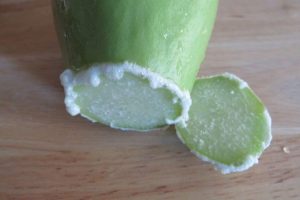
Chinese eggplant :
For this dish, I am partial to the Chinese eggplant because its sweetness is a great foil against all the spices in this dish. While there are over ten varieties of eggplant, I have found that the lack of bitter seeds makes the Chinese version hold the distinct flavors of sayur lodeh together. If you cannot find the Chinese eggplant, you can substitute it with other eggplant varieties.
Coconut milk:
Yes, coconut milk is a high calorie ingredient. But bear in mind, it is also an excellent source of fiber, vitamin C, folate (vitamin B9),iron, magnesium, potassium, copper, manganese, and selenium. Many studies have also found that coconut milk reduces “bad cholesterol” (LDL) and raises the “good cholesterol” (HDL). That said, I am a strong proponent of moderation in everything, and my recipe reflects that approach.
As you can see, this dish is incredibly versatile, healthy, and hearty. You can fast cook it (if you’re in a hurry), or slow cook it. It can be served as a side dish, some times as a soup, or as a main course. But, it does bring a hint of tropical sunshine and heat on a cold fall or winter’s day.
Other variations:
- Use shrimp with tofu
- Broccoli, red cabbage, mushrooms, and French string beans
Other Indonesian recipes that you could try:
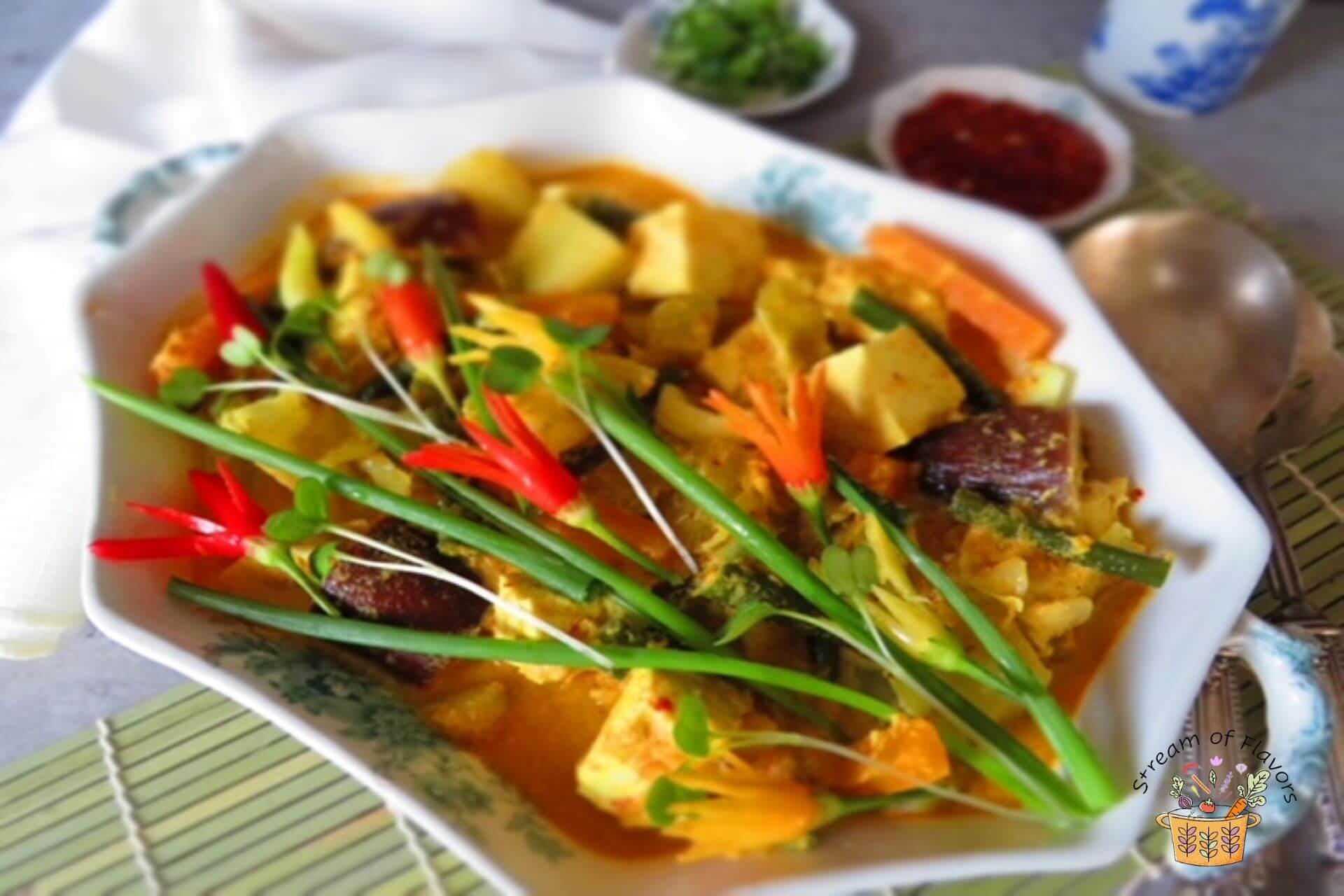
How to make Sayur Lodeh using this recipe:
- How to make the spice paste:
- How to make sayur lodeh:
- How to make the spice paste:
- Soak the dried red chili, dried shrimp and garlic in 2 tablespoons of water for 10 minutes. Grind the soaked ingredients and the rest of the ingredients for the spice paste in a coffee grinder or food processor to a fine paste.
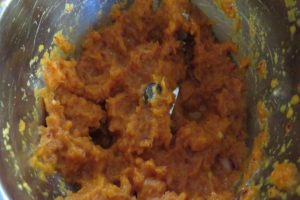
2. How to make the sayur lodeh:
- Heat a Dutch oven. Add the peanut oil and fry the tofu with a pinch of salt for 3 minutes and drain on a paper towel and keep aside.
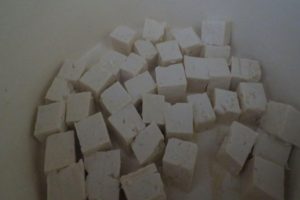
- Next, sauté the spice paste for 2 minutes or until fragrant on medium heat.
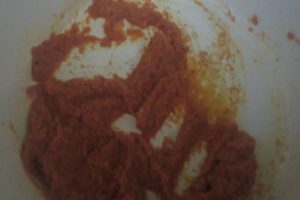
- Add all the vegetables (except the cabbage) and cook with 1/2 cup of water for 5 minutes.
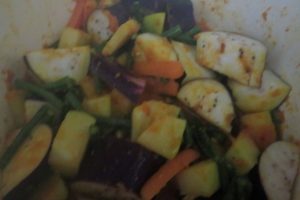
- Add the coconut milk, candlenuts, salt, cabbage, and tofu and cook for 3 minutes. Garnish with cut chilis and scallions. Serve hot with rice cake or steamed rice.

1. Canned coconut milk (both full cream and reduced fat) works just fine.
2. Dried shrimp paste gives the dish the unique flavor. Use a few frozen shrimp if you cannot find the dried shrimp. Just stir-fry the peeled shrimp with the spice paste.
3. Do not overcook or undercook the vegetables. They must be soft yet firm.
How to serve sayur lodeh using this recipe:
Traditionally, the sayur lodeh is served with rice cakes (lotong) or with steamed rice. I like to use jasmine rice to make compressed rice cakes.
How to store:
If you have used fresh coconut milk, then the dish will keep only for a day or two in the refrigerator. Freezing the dish in an airtight box is an option if you have leftover.
Sayur Lodeh Recipe
Equipment
- Stovetop
Ingredients
For the spice paste:
- 1 tsp fresh turmeric peeled, chopped
- 1 tbsp dried shrimp
- 4 dried chili deseeded
- 2 cloves garlic
- 1 tsp galangal
- 1 shallot medium
- 1 lemongrass white part
- 2 tbsp water filtered
For the sayur lodeh:
- 1 chayote cleaned, peeled, cubed
- 1 Chinese eggplant
- 10 long beans
- 1 pack tofu
- 1 green cabbage small
- 1 carrot peeled, cubed
- 1 tbsp peanut oil
- ½ tsp coriander powder
- 3 cups coconut milk from one whole coconut
- ¼ cup candlenuts roasted, powdered
- 1.5 tsp salt
Instructions
How to make the spice paste:
- Soak the dried red chili, dried shrimp and garlic in 2 tablespoons of water for 10 minutes. Grind the soaked ingredients and the rest of the ingredients for the spice paste in a coffee grinder or food processor to a fine paste.
How to make the sayur lodeh:
- Heat a Dutch oven. Add the peanut oil and fry the tofu with a pinch of salt for 3 minutes and drain on a paper towel and keep aside.
- Next, sauté the spice paste for 2 minutes or until fragrant on medium heat.
- Add all the vegetables (except the cabbage) and cook with 1/2 cup of water for 5 minutes.
- Add the coconut milk, salt, candlenuts, cabbage, and tofu and cook for 3 minutes.
Notes
- Chayote must be cleaned (see blog post for instructions) or it will taste bitter in the curry.
- Canned coconut milk can be used for the curry.
- Galangal adds that unique flavor profile to the dish. You could use regular ginger instead.
Nutrition


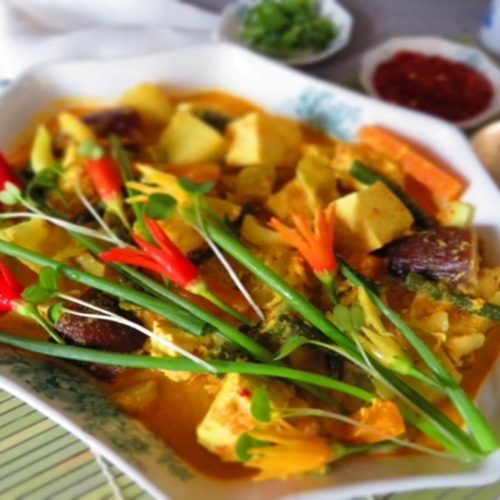





















Thanks for sharing such a nice thinking, post is pleasant, thats why i have read it
fully